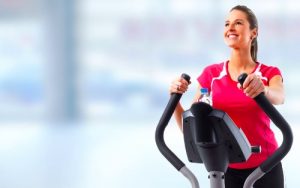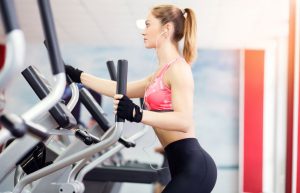Elliptical Training Versus Running: Which Is More Effective?

Running has always been the most common form of exercise. This is because it requires no investment, and can be done anywhere.
As a result, many people both young and old, men and women, have opted for running as their primary athletic activity. However, the emergence of new machines like the elliptical have led to an unresolved debate. Running versus the elliptical: which is more efficient?
Running versus the elliptical: which is right for me?
For those unfamiliar with the elliptical, it is a machine with a movement that resembles an exercise bike, but one you use while standing, and moving your arms and legs at the same time.
You can find professional grade elliptical machines at gyms, as well as semi-pro quality models at sporting goods stores for home use. Although your movements on the machine are similar to those of running, the benefits are different. Let us look at what sets the elliptical apart from running.

A workout for your glutes
Exercising on an elliptical combines the movements of climbing stairs and walking straight ahead. This is a great workout for your glutes, something that is hard to come by with running. Running is more of a workout for the gastrocnemius, the knee area, and the lower thighs.
Toning your quads
The elliptical also provides intense exercise for your quadriceps, one of the longest muscles in the body, and one of the most difficult to work out. You can exercise your quads by running, but the results are more visible in men than in women.
Visible results come faster
Using the elliptical is a more intense workout than running, which is why the results are visible much earlier. After a couple of weeks on the elliptical three times a week, you will see changes in the shape of your muscles and glutes, diminished cellulite if you are a woman, and better muscle tone.
It works your abdomen
The upward motion of your legs on the elliptical means that your abdomen also gets a workout, albeit less than your legs and glutes. However, if you push yourself, you will see terrific results in one or two months.
Lower impact
Many overweight individuals who have suffered some chronic injury cannot run, particularly due to the impact that running inflicts on the joints.
The elliptical does not have this problem. Impact on the joints is minimal, and it can be used by all kinds of people. In fact, it is thought to be the perfect exercise for knee conditions, such as tendinitis, because it strengthens the muscles in this area.

Strengthen your arms
There are two ways to use the machine. One is with the arms motionless at your sides. The other involves pulling the handles, with the legs moving in sync with the arms. This means that your arms get toned, something that does not happen when you are running.
Improve your coordination and balance
When you use both your arms and legs while on the machine, you improve your coordination and balance, as it requires greater concentration.
As the saying goes, “practice makes perfect,” and people with issues in either of these areas will notice considerable improvements in very little time.
Is there any disadvantage?
Depending on the intensity with which you use the machine, you will burn fewer calories than by running. However, this also depends on the pace at which you run. In any case, the elliptical machine is definitely addictive. At first, it may require effort to stay on it for a significant period of time. However, we are certain that with each day you will last a little longer and reach a higher level. And burn plenty of calories in the process.
In the case of elliptical training versus running, it is easy to draw your own conclusions.
Running has always been the most common form of exercise. This is because it requires no investment, and can be done anywhere.
As a result, many people both young and old, men and women, have opted for running as their primary athletic activity. However, the emergence of new machines like the elliptical have led to an unresolved debate. Running versus the elliptical: which is more efficient?
Running versus the elliptical: which is right for me?
For those unfamiliar with the elliptical, it is a machine with a movement that resembles an exercise bike, but one you use while standing, and moving your arms and legs at the same time.
You can find professional grade elliptical machines at gyms, as well as semi-pro quality models at sporting goods stores for home use. Although your movements on the machine are similar to those of running, the benefits are different. Let us look at what sets the elliptical apart from running.

A workout for your glutes
Exercising on an elliptical combines the movements of climbing stairs and walking straight ahead. This is a great workout for your glutes, something that is hard to come by with running. Running is more of a workout for the gastrocnemius, the knee area, and the lower thighs.
Toning your quads
The elliptical also provides intense exercise for your quadriceps, one of the longest muscles in the body, and one of the most difficult to work out. You can exercise your quads by running, but the results are more visible in men than in women.
Visible results come faster
Using the elliptical is a more intense workout than running, which is why the results are visible much earlier. After a couple of weeks on the elliptical three times a week, you will see changes in the shape of your muscles and glutes, diminished cellulite if you are a woman, and better muscle tone.
It works your abdomen
The upward motion of your legs on the elliptical means that your abdomen also gets a workout, albeit less than your legs and glutes. However, if you push yourself, you will see terrific results in one or two months.
Lower impact
Many overweight individuals who have suffered some chronic injury cannot run, particularly due to the impact that running inflicts on the joints.
The elliptical does not have this problem. Impact on the joints is minimal, and it can be used by all kinds of people. In fact, it is thought to be the perfect exercise for knee conditions, such as tendinitis, because it strengthens the muscles in this area.

Strengthen your arms
There are two ways to use the machine. One is with the arms motionless at your sides. The other involves pulling the handles, with the legs moving in sync with the arms. This means that your arms get toned, something that does not happen when you are running.
Improve your coordination and balance
When you use both your arms and legs while on the machine, you improve your coordination and balance, as it requires greater concentration.
As the saying goes, “practice makes perfect,” and people with issues in either of these areas will notice considerable improvements in very little time.
Is there any disadvantage?
Depending on the intensity with which you use the machine, you will burn fewer calories than by running. However, this also depends on the pace at which you run. In any case, the elliptical machine is definitely addictive. At first, it may require effort to stay on it for a significant period of time. However, we are certain that with each day you will last a little longer and reach a higher level. And burn plenty of calories in the process.
In the case of elliptical training versus running, it is easy to draw your own conclusions.
All cited sources were thoroughly reviewed by our team to ensure their quality, reliability, currency, and validity. The bibliography of this article was considered reliable and of academic or scientific accuracy.
- Burnfield JM, Shu Y, Buster TW, Taylor AP, Nelson CA. Impact of elliptical trainer ergonomic modifications on perceptions of safety, comfort, workout, and usability for people with physical disabilities and chronic conditions. Phys Ther. 2011 Nov;91(11):1604-17.
- Damiano DL, Norman T, Stanley CJ, Park HS. Comparison of elliptical training, stationary cycling, treadmill walking and overground walking. Gait Posture. 2011 Jun;34(2):260-4.
- Kaplan Y, Nyska M, Palmanovich E, Shanker R. Clinical Implications of Changing Parameters on an Elliptical Trainer. Orthop J Sports Med. 2014 Jun 4;2(6):2325967114535553.
- Lin CY, Tsai LC, Press J, Ren Y, Chung SG, Zhang LQ. Lower-Limb Muscle-Activation Patterns During Off-Axis Elliptical Compared With Conventional Gluteal-Muscle-Strengthening Exercises. J Sport Rehabil. 2016 May;25(2):164-72.
This text is provided for informational purposes only and does not replace consultation with a professional. If in doubt, consult your specialist.








